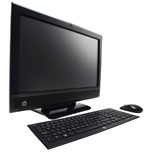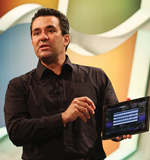Citing "cool" factor, partners see the next OS interface as unifying Microsoft's platforms. Concerns surround how the touch orientation will translate to the desktop, and whether thorny OEM and development issues find quick resolutions.
- Read the condensed Web-exclusive version of this feature, which includes a Windows 8 demo video, here.
Microsoft had been so secretive about the OS until that point that the company wouldn't confirm "Windows 8" as the code name, not even after CEO Steve Ballmer referred to the OS as Windows 8 in a speech.
Such secrecy didn't actually imply that anything particularly special was going on. Windows and Windows Live Division President Steven Sinofsky customarily says the absolute minimum about pre-release code, and very few observers were expecting Microsoft to offer an exciting response to the burgeoning slate/media tablet market that Apple Inc. has been making with the iPad.
But the short Web video demo, tied to Microsoft speeches at both the D9 Conference and the Computex electronics show, changed all expectations for Windows 8.
The Microsoft partner community, for the most part, appeared energized by the demo run by Jensen Harris, director of program management for the Windows User Experience Team. In interviews, Microsoft partners said they were enthusiastic about the design and the tablet potential of Windows 8, although some harbored concerns about how the touch-orientation will translate to desktop work, and about where the platform leaves developers and OEMs.
The Windows 8 UI is the most dramatic overhaul of the GUI since Windows 95. The Microsoft demo video instantly calls to mind the interface of Windows Phone 7 and its follow-on, code-named Windows Phone 7 "Mango." Applications appear as tiles, and Harris moved between screens of tiles by swiping his finger across the surface. He introduced some new UI motions, such as sequentially cycling through running apps by swiping them in from the side, snapping apps into place to fill part of the screen and a new touch keyboard that puts half the keyboard in the lower-left corner of the screen and the other half in the lower right.
 |
| Would you want to touch that screen? A big question with the Windows 8 UI is whether users will actually want to touch not only a tablet screen but a desktop screen. The HP TouchSmart 610 that had its debut at Computex is available now, but would essentially be Windows 8-ready for users who like the idea of tapping and dragging on a desktop monitor. |
Partners almost universally applauded the interface, especially for tablet-style use.
"My initial impression is that the UI for Windows 8 will be a huge step forward for partners," says Barb Levisay, owner of Marketing for Partners in Ruckersville, Va. "Partners have thrived working with the current business decision makers because this generation is comfortable with Microsoft. As the next generations -- the technology natives -- take over the strategic purchasing decisions, we have to present information on their terms. Windows 8 looks like it has hit that mark."
Levisay added that Windows 8 could bring something else to the Microsoft channel. "The partners' ability to attract talent is clearly affected by the coolness factor. With app development and touch, Windows 8 could give us back some cool. We need young, energetic entrepreneurs that are proud to sell Microsoft products -- just like the partners of today were in the '80s and '90s," she says.
Howard Cohen, a New York-based consultant to IT vendors and channel partner companies, says he was most encouraged by how Microsoft referred to "re-imagining" Windows, a step he believes was long overdue. "Let's remember the two things everyone said when Windows 7 came out: 'Hey, it's Vista except it works,' and 'Hey, they're trying to make it look more like a Mac!'" Cohen says. "Well, now they've finally leapfrogged Apple and delivered a more natural, comfortable interface that really gets out of the users' way and lets them concentrate on doing what they came to do."
He added: "For the first time in a long time, I feel like Microsoft may finally reclaim a leadership position in user interface design."
Amy Babinchak, president of Harbor Computer Services in Michigan, says it's too early to say what business opportunities Windows 8 might present, but she called the release exciting. "I traded in my iPhone for a [Windows Phone 7-based device] a few months ago and haven't looked back," she says. "I think the live tile interface with touch, keyboard and mouse is going to burst open the world of devices. This is a very exciting time to be in IT."
Describing the interface as a "really huge move by Microsoft" was Jerry Weinstock, business development manager for CRM Innovation LLC in Lenexa, Kan.
"The new Windows 8 UI is a sea change event that will make the user experience between computing platforms -- desktops, notebooks, phones and tablets -- a more seamless process," he says. "Touchscreen technology is finally reaching its promise. I can't wait to see how this core change in the OS will enhance business applications like Microsoft Dynamics CRM."
Geno Cenci, Microsoft national practice director for ePlus Technology Inc., says he was impressed with the demos he'd seen. "They seem to have completely focused on tablets/touch/usage/apps/Web/cloud, and so on, and even getting involved with the hardware," he noted.
"While their competitors take a mobile OS and attempt to optimize it for larger devices, Microsoft took an extremely different approach by developing an OS that's capable on both traditional machines and portable devices," Cenci says. "As the UI interface was slick, I think customers will start to ask about open integration with other online services besides Windows Live in the operating system and its core applications."
An open question for Microsoft has been if or how Windows will really work on what the world calls a tablet, and on what Microsoft calls a slate or media tablet. "[Windows 8] is their answer: This is the way a tablet is going to work. If you can get it into the right profile hardware, that's going to be incredibly cool," says Dave Sobel, founder and CEO of Evolve Technologies LLC in Fairfax, Va. "I'm kind of excited about where this could go."
Desktop Question Marks
One partner who doesn't share the view that Windows 8 leapfrogs Apple is Karl Palachuk, CEO of KPEnterprises Business Consulting Inc. in Sacramento, Calif. "My first impression is that you can't help thinking it looks like an iPad," he noted. While Palachuk liked the fast, clean interface for handheld devices, he and many other partners weren't sure it would work on the desktop.
"I don't think most people want to reach across their desk to put their hands onto a 22-inch monitor to get their work done. Perhaps we'll see touch monitors that eliminate the keyboard and sit at an angle on the desktop," Palachuk says. "The most obvious change for the channel is that we can see touchscreens and ergonomic discussions in our future. While the 'Star Trek' concept of wall computing looks cool, it would be exhausting to reach up all day to work on a screen. That means the screen has to come down and the hands have to come down. If you've got one surface for typing and viewing, then your head tilts down. Ergonomically, this interface doesn't seem to make sense on the desktop."
Sobel had almost the same reaction to the desktop question. "I'm sitting at my conventional desktop with my 27-inch display. How much do I really want to touch it to interface with it? Really, not that much," he says.
 Mike Angiulo, Microsoft corporate vice president of Windows Planning, Hardware and PC Ecosystem, shows off the new "Windows 8" start page at the Computex event in Taipei, Taiwan, June 2, 2011.
Mike Angiulo, Microsoft corporate vice president of Windows Planning, Hardware and PC Ecosystem, shows off the new "Windows 8" start page at the Computex event in Taipei, Taiwan, June 2, 2011. Lieberman finds the interface neither revolutionary nor particularly interesting. "It's clear that this is a kneejerk reaction to the iPad and a vain attempt to provide something comparable," he says. "I really hope they still support the existing icon-based interface. Otherwise, Windows 8 will be the next version of Windows BOB."
Sobel noted that the demo exposed a Windows 7 interface that's clearly still there, and Palachuk agreed that the ability to easily switch interfaces will be important. "I suspect this new interface has some very cool features that no one will use after the first month. Like Windows Aero," Palachuk says.
Babinchak suspected clients would require a mix of interfaces that partners would need to help them configure. "The Windows desktop has been around for a long, long time. Some people have had a hard time letting go of the [Windows] XP desktop experience. Getting those same people to move into tiles is going to be interesting. I think we might see a distinct separation between the dinosaurs and the productive workers," she says.



No comments:
Post a Comment